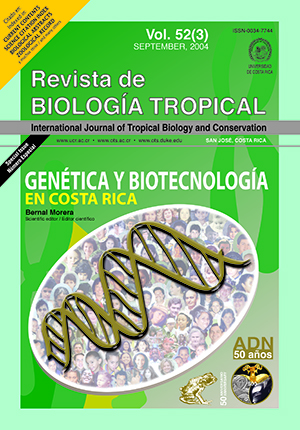Resumen
En el año 2000 se reportó por primera vez la principal plaga del cafeto, conocida como broca (Hypothenemus hampei Ferrari) (Coleoptera: Scolitidae) en plantaciones de este cultivo en Costa Rica. Debido al impacto que esta plaga tiene en la economía del país, surgió la necesidad de encontrar una alternativa para el control biológico de esta plaga, basadas en la bacteria entomopatógena Bacillus thuringiensis. El objetivo de este trabajo fue aislar y caracterizar cepas de Bacillus thuringiensis a partir de plantaciones de café infestadas con H. hampei. Se aislaton 202 cepas que se analizaron mediante la morfología del cristal, SDS-PAGE de las d-endotoxinas, mientras que 105 cepas se evaluaron mediante PCR para determinar la presencia de genes cry, cyt y vip. La mayoría de las cepas presentaron diversas morfologías del cristal: pleomórficos (35%), ovalados (37%), bipiramidales (3%), bipiramidales y ovalados (12%), bipiramidales, ovalados y pleomórficos (10%) y bipiramidales, ovalados y cúbicos (3%). El análisis electorforético de las proteínas mostró que 5 cepas contenían d-endotoxinas con pesos moleculares entre los 20 y 40 kDa, 6 entre los 40 y 50 kDa, 7 entre los 50 y 60 kDa, 19 cepas entre los 60 y 70 kDa, 29 entre los 70 y 100 kDa y 39 cepas entre los 100 y 145 kDa. Los análisis mediante PCR mostró que la colección presenta una gran diversidad de genes cry, observándose varios genes por cepa: 78 cepas presentaron el gen vip3, 82 el gen cry2, 45 el gen cry1 y 29 cepas los genes cry3 y cry7. Un total de 13 cepas no amplificaron con los iniciadores cry1, cry2, cry3-7, cry5, cry11cry12 y cry14. Se encontraron 43 perfiles genéticos diferentes, detectándose principalmente la combinación de genes cry1A con otros genes cry o vip. La caracterización genética de esta colección provee información importante para la selección de cepas de Bacillus thuringiensis que se evaluarán mediante bioensayos contra Hypothenemus hampei u otras plagas de importancia económicaCitas
Apoyolo, C.I., L. Drif, J.M.Vassal, H. Debarjac, J.P. Bossy, F. Leclant & R. Frutos. 1995. Isolation of multiple subspecies of Bacillus thuringiensis from a population of the European sunflower moth, Homoeosoma nebulella. Appl. Environ. Microbiol. 61: 4343-4347.
Arrieta, G. 2003. Caracterización molecular de las d-endotoxinas de una colección de Bacillus thuringiensis aislada a partir de ecosistemas silvestres y agrícolas de Costa Rica. Tesis de Maestría, Universidad de Costa Rica, San José, Costa Rica. 110 p.
Bechtel, D. B. & L.A. Bulla. 1976. Electron microscopic study of sporulation and parasporal formation in Bacillus thuringiensis. J. Bacteriol. 127: 1472-1481.
Ben-Dov, E., A. Zaritsky, E. Dahan, Z. Barak, R. Sinai, R. Manasherob, A. Khamraev, E. Troitskaya, A. Dubitsky, N. Berezina & Y. Margalith. 1997. Extended screening by PCR for seven cry-group genes from field-collected strains of Bacillus thuringiensis. Appl. Environ. Microbiol. 63: 4883-4890.
Bernhard, K. 1986. Studies on the delta-endotoxin of Bacillus thuringiensis var. Tenebrionis. FEMS Microbiol. Lett. 33: 261-265.
Bernhard, K., Jarret P., M. Meadows, J. Butt, D.J. Ellis, G.M. Roberts, S. Pauli, P. Rogers & H.D. Burges. 1997. Natural isolates of Bacillus thuringiensis: worldwide distribution, characterization and activity against insect pest. J. Invertebr. Pathol. 70: 59-68.
Brun, L.O., C. Marcillaud, V. Gaudichon & D.M. Suckling. 1989. Endosulfan resistance in Hypothenemus hampei (Coleoptera: Scolytidae) in New Caledonia. J. Econ. Entomol. 82: 1312-1316.
Bravo, A., S. Sarabia, L. López, H. Ontiveros, C. Abarca, A. Ortiz, M. Ortiz, L. Lina, J. Villalobos, G. Peña, V. Noez, M. Soberón & R. Quintero. 1998. Characterization of cry genes in a Mexican Bacillus thuringiensis strain collection. Appl. Environ. Microbiol. 64: 4965- 4972.
Carozzi, N. B., V.C. Kramer, G. W. Warren, S. Evola & M.G. Koziel. 1991. Prediction of insecticidal activity of Bacillus thuringiensis strains by polymerase chain reaction product profiles. Appl. Environ. Microbiol. 57: 3057-3061.
Chen W. & T. Kuo. 1993. A simple and rapid method for the preparation of gram-negative bacterial genomic DNA. Nucleic Acid Research 21: 2260.
Estruch, J.J., G.W. Warren, M.A. Mullins, G.J. Nye, J.A. Craig & M.G. Koziel. 1996. Vip3A, a novel Bacillus thuringiensis vegetative insecticidal protein with a wide spectum of activities against lepidopteran insects. Proc. Natl. Acad. Sci. 93: 5389-5394.
Ferrandis, M. D., V. M. Juárez-Pérez, R. Frutos, Y. Bel & J. Ferré. 1999. Distribution of cry1, cryII and cryV genes within Bacillus thuringiensis isolates from Spain. Syst. Appl. Microbiol. 22: 179-185.
Gustafson, M.E., R.A. Clayton, P.B. Lavrik, G.V. Jonhson, R.M. Leimgruber, S.R. Sims & D.E. Bartnicki. 1997. Large-scale production and characterization of Bacillus thuringiensis subsp. tenebrionis insecticidal protein from Escherichia coli. Appl. Microbiol. Biotech. 47: 255-261.
Hatanaka, T., Y. Choi, T. Kusano & H. Sano. 1999. Transgenic plants of coffee Coffea arabica from embryogenic callus via Agrobacterium tumefaciens-mediated transformation. Plant Cell Reports 19: 106-110.
Kim, H.S., D.W. Lee, S.D. Woo, Y.M. Yu & S.K. Kang. 1998. Distribution, serological identification, and PCR analysis of Bacillus thuringiensis isolated from soils of Korea. Curr. Microbiol. 37: 195-20.
Le Pelley, R.H. 1968. Pest of coffee. London, Longman. 590 p.
Méndez-López, I., R. Basurto-Ríos & J. Ibarra. 2003. Bacillus thuringiensis serovar israelensis is highly toxic to the coffee berry borer, Hypothenemus hampei Ferr. (Coleoptera: Scolytidae). FEMS Microbiol. Lett. 11131: 1-5.
Porcar, M. & V. Juárez-Pérez. 2003. PCR-based identification of Bacillus thuringiensis pesticidal crystal genes. FEMS Microbiol. Rev. 26: 419-432.
Samsonov, P., R.I. Padrón, C. Pardo, J. Cabrera & G.A. De al Riva. 1997. Bacillus thuringiensis from biodiversity to biotechnology. J. Ind. Microbiol. Biotech. 19: 202-219.
Sanchis, V., D. Lereclus, G. Menou, J. Chaufaux & M.M. Lecadet. 1988. Multiplicity of d-endotoxin genes with different specificities in Bacillus thuringiensis aizawai. Mol. Microbiol. 2: 393-404.
Schnepf, H.E., N. Crickmore, N. Van Rie, J. Dereclus, J. Baum, J. Feitelson, D.R. Zeigler & D.H. Dean. 1998. Bacillus thuringiensis and its pesticidal crystal proteins. Microbiol. Mol. Biol. Rev. 62: 775-806.
Travers, R. S., P.A.W. Martin & C.F. Reichelderfer. 1987. Selective process for efficient isolation of soil Bacillus spp. Appl. Environ. Microbiol. 53: 1263-1266.
##plugins.facebook.comentarios##

Esta obra está bajo una licencia internacional Creative Commons Atribución 4.0.
Derechos de autor 2004 Revista de Biología Tropical


